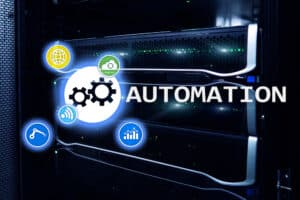
Hyperautomation is too compelling for businesses to ignore. They look to use it lower operational costs, reduce human errors, support governance efforts, and more.
Automation has become pervasive, and now, many points of automation are converging into what Gartner calls “hyperautomation,” or “a business-driven, disciplined approach that organizations use to rapidly identify, vet and automate as many business and IT processes as possible,” involving the “orchestrated use of multiple technologies, tools or platforms, including: artificial intelligence and machine learning.”
Within the next two years, more than 70% of the large global enterprises will have over 70 concurrent hyperautomation initiatives mandating governance or facing significant instability,” Gartner predicts, as relayed by Brian McHugh in an ActiveBatch post. In addition, hyperautomation will lower operational costs by at least 30%. There will also be a renewed push for additional investment for IP, curated data, architecture, integration and development to support the drive toward hyperautomation, Gartner says.
The promise of automation — and hyperautomation — is too compelling for businesses to ignore. “By automating, organizations can reduce human error and make processes more efficient by removing human interventions and delays,” McHugh says. “Overall, automating processes end-to-end means fewer resources are needed to successfully complete the process, a boon for organizations that need to reduce operating costs while simultaneously providing faster services.”
See also: 5 Steps CIOs Can Take to Democratize Automation
A recent survey of 600 CIOs and business leaders by Salesforce confirms this level of interest in the next phase of automation, with 80% of organizations planning for hyperautomation on their technology roadmaps within the next 24 months.
However, there is a lot of work that needs to be done before automation can accelerate to these levels, the Salesforce survey finds. While business demand for automation has surged — with 91% of executives wanting more of it — throwing automation at problems without deliberation may cause more issues than it solves.
Automation is often seen as a panacea, but is hampered by existing technology architectures. In addition, 80% of organizations are concerned supporting automation is likely to compound technical debt, or money sinks resulting from quick fixes to systems, or heavy-but-misguided investments.
Companies are turning to automation to handle tasks within sales, customer service, marketing and commerce, the study observes. The highest demand for automation came from four departments: research and development (39%), administrative/operations (38%), customer service (33%), and marketing (26%).
Existing technology stacks are impacting the speed at which IT teams are able to meet automation demands from the business. Nearly all respondents, 96%, said that modifying and rebuilding automations is a challenge as systems and business requirements change. In addition, four in five said restructuring existing application and data landscapes to support automation would likely compound their organization’s technical debt.
Nearly half (44%) are now using integration and API management capabilities to support their business process automation efforts. Another 53% stated they were using integration and API management capabilities to “some extent,” indicating a lingering gap in efforts to more efficiently automate workflows at scale and deliver connected customer experiences faster.
Ultimately, hyperautomation means more of a “touchless” business environment that requires greater attention to integration and management of digital environments. Within a year’s time, Gartner predicts, “organizations will be able to run a full 25% more tasks autonomously,” McHugh relates. “While much of this will be achieved through the use of robotic process automation (RPA) in front-end offices, critical operations, infrastructure, and data processes will need to be automated with more robust orchestration and automation tools that provide programmatic integrations and deeper functionality.”





























